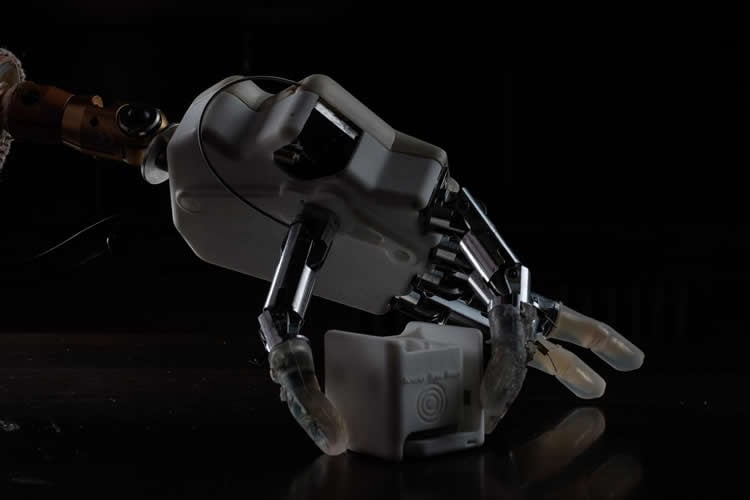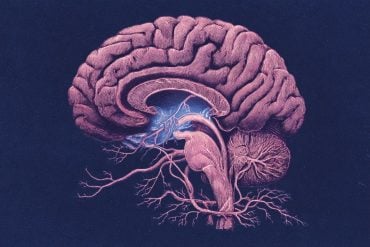Summary: A new prosthetic hand enables amputees to regain a subtle, close to natural, sense of touch.
Source: EPFL.
The next-generation bionic hand, developed by researchers from EPFL, the Sant’Anna School of Advanced Studies in Pisa and the A. Gemelli University Polyclinic in Rome, enables amputees to regain a very subtle, close-to-natural sense of touch. The scientists managed to reproduce the feeling of proprioception, which is our brain’s capacity to instantly and accurately sense the position of our limbs during and after movement – even in the dark or with our eyes closed.
The new device allows patients to reach out for an object on a table and to ascertain an item’s consistency, shape, position and size without having to look at it. The prosthesis has been successfully tested on several patients and works by stimulating the nerves in the amputee’s stump. The nerves can then provide sensory feedback to the patients in real time – almost like they do in a natural hand.
The findings have been published in the journal Science Robotics. They are the result of ten years of scientific research coordinated by Silvestro Micera, a professor of bioengineering at EPFL and the Sant’Anna School of Advanced Studies, and Paolo Maria Rossini, director of neuroscience at the A. Gemelli University Polyclinic in Rome.
Sensory feedback
Current myoelectric prostheses allow amputees to regain voluntary motor control of their artificial limb by exploiting residual muscle function in the forearm. However, the lack of any sensory feedback means that patients have to rely heavily on visual cues. This can prevent them from feeling that their artificial limb is part of their body and make it more unnatural to use.
Recently, a number of research groups have managed to provide tactile feedback in amputees, leading to improved function and prosthesis embodiment. But this latest study has taken things one step further.
“Our study shows that sensory substitution based on intraneural stimulation can deliver both position feedback and tactile feedback simultaneously and in real time,” explains Micera. “The brain has no problem combining this information, and patients can process both types in real time with excellent results.”
Intraneural stimulation re-establishes the flow of external information using electric pulses sent by electrodes inserted directly into the amputee’s stump. Patients then have to undergo training to gradually learn how to translate those pulses into proprioceptive and tactile sensations.

This technique enabled two amputees to regain high proprioceptive acuity, with results comparable to those obtained in healthy subjects. The simultaneous delivery of position information and tactile feedback allowed the two amputees to determine the size and shape of four objects with a high level of accuracy (75.5%).
“These results show that amputees can effectively process tactile and position information received simultaneously via intraneural stimulation,” says Edoardo D’Anna, EPFL researcher and lead author of the study.
Prestigious European research centers contributed to the study. The university of Cagliari, the University of Montpellier and the University of Freiburg (Germany).
Funding: Funding was provided by the European Commission, the Swiss National Centre of Competence in Research (NCCR Robotics), and the Bertarelli Foundation.
Source: Silvestro Micera – EPFL
Publisher: Organized by NeuroscienceNews.com.
Image Source: NeuroscienceNews.com image is credited to Luca Rossini.
Original Research: Open access research for “A closed-loop hand prosthesis with simultaneous intraneural tactile and position feedback” by Edoardo D’Anna, Giacomo Valle, Alberto Mazzoni, Ivo Strauss, Francesco Iberite, Jérémy Patton, Francesco M. Petrini1, Stanisa Raspopovic, Giuseppe Granata, Riccardo Di Iorio, Marco Controzzi, Christian Cipriani, Thomas Stieglitz, Paolo M. Rossini and Silvestro Micera in Science Robotics. Published February 20 2019.
doi:10.1126/scirobotics.aau8892
[cbtabs][cbtab title=”MLA”]EPFL”New Prosthetic Restores the Sense of Where Your Hand Is.” NeuroscienceNews. NeuroscienceNews, 21 February 2019.
<https://neurosciencenews.com/sense-prosthetic-hand-10792/>.[/cbtab][cbtab title=”APA”]EPFL(2019, February 21). New Prosthetic Restores the Sense of Where Your Hand Is. NeuroscienceNews. Retrieved February 21, 2019 from https://neurosciencenews.com/sense-prosthetic-hand-10792/[/cbtab][cbtab title=”Chicago”]EPFL”New Prosthetic Restores the Sense of Where Your Hand Is.” https://neurosciencenews.com/sense-prosthetic-hand-10792/ (accessed February 21, 2019).[/cbtab][/cbtabs]
Abstract
A closed-loop hand prosthesis with simultaneous intraneural tactile and position feedback
Current myoelectric prostheses allow transradial amputees to regain voluntary motor control of their artificial limb by exploiting residual muscle function in the forearm. However, the overreliance on visual cues resulting from a lack of sensory feedback is a common complaint. Recently, several groups have provided tactile feedback in upper limb amputees using implanted electrodes, surface nerve stimulation, or sensory substitution. These approaches have led to improved function and prosthesis embodiment. Nevertheless, the provided information remains limited to a subset of the rich sensory cues available to healthy individuals. More specifically, proprioception, the sense of limb position and movement, is predominantly absent from current systems. Here, we show that sensory substitution based on intraneural stimulation can deliver position feedback in real time and in conjunction with somatotopic tactile feedback. This approach allowed two transradial amputees to regain high and close-to-natural remapped proprioceptive acuity, with a median joint angle reproduction precision of 9.1° and a median threshold to detection of passive movements of 9.5°, which was comparable with results obtained in healthy participants. The simultaneous delivery of position information and somatotopic tactile feedback allowed both amputees to discriminate the size and compliance of four objects with high levels of performance (75.5%). These results demonstrate that tactile information delivered via somatotopic neural stimulation and position information delivered via sensory substitution can be exploited simultaneously and efficiently by transradial amputees. This study paves a way to more sophisticated bidirectional bionic limbs conveying richer, multimodal sensations.






